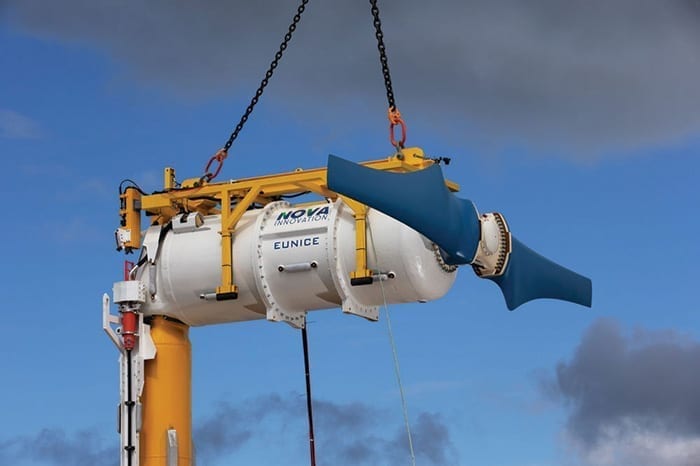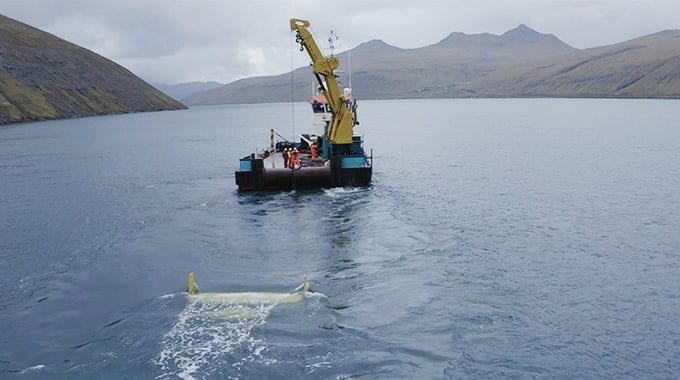Ocean Power Developers Made Crucial Progress in 2020
Tidal and wave energy installations in 2020 brought global cumulative installations for ocean energy to almost 60 MW. Another 6 MW of wave and tidal energy is slated for deployment this year, suggesting marked growth for the fledgling sector.
According to industry group Ocean Energy Europe, despite challenges and uncertainty over 2020 that tested the sector’s resilience, several novel tidal stream projects were deployed last year, adding 865 kW to cumulative installations. An assortment of wave energy devices were also deployed, bringing wave energy’s global total to 23.3 MW. While installations slowed compared to past years, “[t]o install devices and avoid cancellations during a global pandemic is clear evidence of ocean energy’s resilience to shocks and slowdowns,” noted Ocean Energy Europe.
Existing tidal farms and new demonstration projects notably pushed up tidal stream power production to 60 GWh for the first time. About 12 GWh came from European pilot farms—Meygen, Oosterschelde, and the pan-European Enabling Future Arrays in Tidal (EnFAIT) project. Among novel projects deployed last year are several in Scotland.
 |
|
1. Eunice—a next-generation direct-drive tidal turbine—is one of four turbines installed at the Shetland Tidal Array in Scotland as part of the EnFAIT project, which aims to make tidal energy a commercial reality. Courtesy: NOVA Innovation |
Irish company DesignPro Renewables early in 2020 completed the deployment and successful testing of its 60-kW (DPR60) turbine at Kirkwall in the Orkney Islands, Scotland. Also notable is Scottish tidal technology developer NOVA Innovation’s expansion of the Shetland Tidal Array as part of the EnFAIT project with a fourth turbine. The new turbine, dubbed “Eunice,” is a commercial direct-drive tidal turbine (Figure 1). According to NOVA, the next generation of direct-drive turbines could slash the “cost of tidal energy by a third—making tidal energy cost competitive with fossil fuels.”
Now in its third year, the five-year EnFAIT project will shift its focus from learning from the three existing turbines and onto installing direct-drive turbines to demonstrate cost advantages. “We are driving down costs and branching into new markets to make tidal energy mainstream,” said NOVA CEO Simon Forrest. “By 2030, tidal energy will be cheaper than nuclear power and fossil fuels, providing cleaner and sustainable energy for coastal communities around the world.”
 |
|
2. As a part of the ongoing commissioning work of its DG100 tidal kite system in Vestmannasund, Faroe Islands, leading marine energy developer Minesto has reached the milestone of delivering electricity to the Faroese grid facilitated by a power purchase agreement with the utility company SEV. Courtesy: Minesto |
Minesto, a commercial vendor of a tidal kite, in 2020 marked two pivotal milestones. In February, it secured a power purchase agreement (PPA) with Faroe Islands power entity SEV for 2.2 MW—a deal that comprises the planned installations of two grid-connected 100-kW Minesto Deep Green kites, as well as future utility-scale systems of at least 2 MW. And in December, it began delivering power to the Faroese grid under that PPA, after installing and commissioning one 100-kW DG100 tidal kite system (Figure 2).
“The DG100 commissioning progress means that Minesto now has initiated the process of generating renewable electricity from the tidal flows in Vestmannasund, using the Deep Green technology’s unique principle of enhancing the speed of the kite through the water to power homes connected to the Faroese grid,” the company said. Minesto in March said it is now working to scale up the DG100 product to a 1.2-MW power plant.
Outside of Europe, interest in the tidal market is taking off, especially in Canada, where the government stepped up to finance Sustainable Marine’s Plat-I floating tidal energy platform. In February, Sustainable Marine said the 420-kW PLAT-I 6.40 floating tidal energy platform—which it calls the “world’s first floating tidal energy array”—was completed in Meteghan, Nova Scotia, and launched in the Bay of Fundy, which experiences the highest tides on earth. The platform will undergo commissioning and testing in Grand Passage and then be moved to the FORCE (Fundy Ocean Research Centre for Energy) site as part of the first phase of the ground-breaking 9-MW Pempa’q In-stream Tidal Energy Project.
In the U.S., Verdant Power last October installed an array of three tidal turbines at its Roosevelt Island Tidal Energy (RITE) Project site in New York City’s East River. The RITE Project activity is a technology demonstration of Verdant Power’s fifth-generation tidal power system and its novel TriFrame mounting system, the company told POWER.
In January, Verdant said that the one-half scale demonstration—of a grid-connected array of three, five-meter diameter rotor tidal power turbines—has performed at 100% availability, producing 100 MWh in only 85 days of continuous operation. That’s “a record for marine energy production in the United States,” the company noted. “This high reliability is critical to cost-competitive green energy.”
China is quietly marking substantial progress, too. In April, the China Three Gorges Corp., operator of its namesake dam, which remains the largest hydropower project in the world, installed a 500-kW tidal turbine designed by European developer SIMEC Atlantis Energy. As significantly, in October, Chinese technology developer GIEC successfully installed a 500-kW structure combining a wave energy conversion and aquaculture. China’s deployment of a “full-scale wave energy converter” indicates it is positioning itself as a global competitor, said Ocean Energy Europe.
Finally, in another notable wave energy development in December, Danish company Wavepiston moved to PLOCAN in the Spanish Canary Islands to test two full-scale devices in a 200-kW project. The device serves dual purposes, reflecting a trend among some wave developers to both produce power and freshwater, in response to increased demand from islands.
“The installation of this wave device in Spain signals the beginning of a series of deployments planned in the region over the coming years. Several major projects have been announced in Portugal, Spain, Italy and Greece, as these countries show increasing support for wave energy,” noted Ocean Energy Europe.
—Sonal Patel is POWER’s senior associate editor.